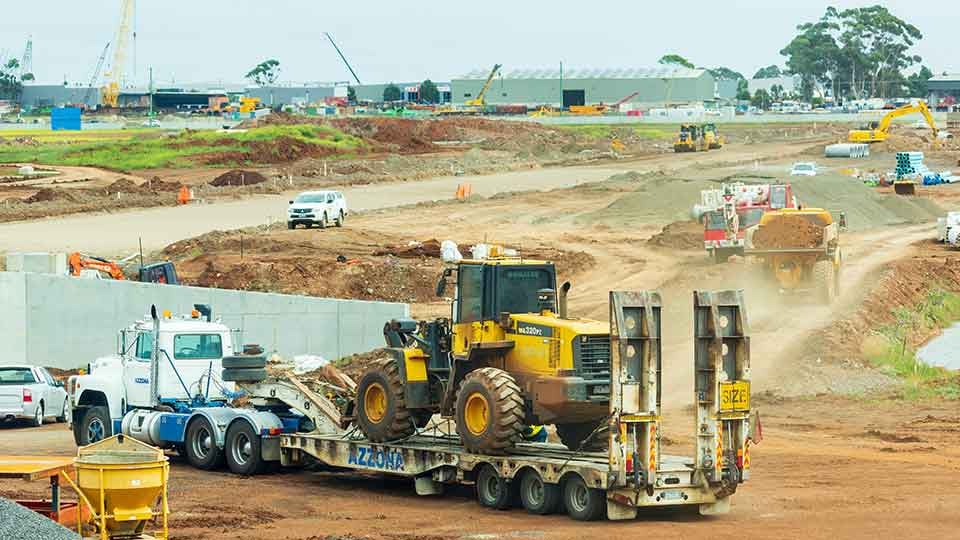Active construction jobsites are dynamic and busy places. With tight timelines and budgets, it’s vital that everything goes well…and often, they don’t. Multiple trades, weather, budget changes, supply chain issues, worker shortages and more keep things busy and evolving.
One thing you don’t need at a jobsite is delays due to problems with deliveries and pick-ups. Whether you are expecting a delivery of equipment or raw materials, the success of your project depends on things arriving on time.
Transportation is also a dynamic industry. At Anderson Trucking Service (ATS), we deal with last-minute changes every day. We see how nerve-wracking it can be when projects don’t go as planned and we see how planning for contingencies can help things go more smoothly.
Many of these same variables also apply to the jobsite. While every jobsite is unique, there are some common variables to prepare for. This article will address some common hurdles with jobsite shipments and help you solve these problems before they start.
Give Trucks Jobsite Access
Some jobsites are difficult to access, especially with a truck and trailer. Limited access points, security checks, safety and traffic issues complicate getting a truck in and out of construction sites. Before specifying a load at your jobsite, ensure the driver and vehicle will be able to access the site. Some things to consider are:
-
Entrances
Is there a large enough entrance for the truck to enter, turn, load or unload, and then exit? If there is only one access point that will accommodate a truck, will it be available when the driver arrives? Make sure the driver understands where the entrance is and which entrance to use.
Restricted jobsites also need to be accessible. Work with your carrier to ensure the driver has the information they need to enter (such as a passcode), or that the security team is expecting them.
-
Driver Credentials
If the driver needs a TWIC card, U.S. citizenship or a military background clearance to enter the site, specify that information to the carrier or broker. If the driver cannot enter, you will lose valuable time while the provider searches for a new driver.
Not preparing for access is likely to mean additional fees. If the driver is unable to reach the site, expect to pay at least $50 an hour for the time the driver is idle while the problem is solved.

What Kind of Truck Do You Need?
Particularly on construction sites, the right type of truck and trailer can be critical. RGN trailers, for example, often don’t have the clearance needed to drive on a rough lot. Dry vans can’t be loaded with a crane. If the driver shows up with the wrong type of vehicle, you lose time and money until a suitable replacement is found.
Experienced shippers may know exactly what type of truck they need. But regardless of your experience, the best way to make sure the correct vehicle and a qualified driver arrive at the appointed time is to be very clear in your specification.
When the carrier knows exactly what will be transported, how it will be loaded and the length, width, height and weight of the cargo, they will assign a truck that will accommodate loading, transit and unloading.
When the driver and truck arrive, they usually plan for two hours onsite before detention fees kick in. Carefully scheduling jobsite deliveries and pick-ups will help keep your project running on time and on budget.
Scheduling Truck Arrivals at the Jobsite
Jobsite scheduling means dealing with constantly shifting variables, including weather, available staff and equipment, and workspeed. With all the moving pieces, scheduling is critical. Raw materials must be delivered on time and finished components need to be distributed.
The more the provider knows about your jobsite, the better they will be able to accommodate your needs. Here are some tips to employ as you schedule your shipments:
- Clearly communicate delivery and pick-up windows. If your site is only open and receiving trucks for limited hours, include that information in your specification.
- Stagger truck arrivals so that access points are kept clear and space is available to load/unload.
- Verify that components are ready before the truck comes to pick them up. Making a change at the last minute will be less expensive than turning a truck away when it arrives as scheduled.
- When scheduling deliveries and pick-ups for later in the project, specify the anticipated need date. Then stay in touch with the provider to make changes as needed.
- Double check that specialty equipment like cranes will be onsite as necessary.
- Contact your carrier with scheduling changes as soon as possible.
Keep your transportation provider in mind during scheduling. Failing to plan is often planning to fail…or planning to pay accessorial charges.
Plan Ahead for Jobsite Delivery
Your project can’t afford delays and extra fees. You have a job to get done and a schedule to keep. Every hour spent dealing with a problem is an hour lost.
Luckily, as with most things, good communication with your broker or carrier can make all the difference when it comes to keeping everything running. Here are some tips for communicating:
- Be thorough in your specification. The provider will use the type of commodity you are shipping, as well as the length, width, height and weight to provide the best tractor and trailer type, and to make sure any permits are procured. These measurements need to be accurate to ensure smooth transit.
- Stay in contact with your provider. Many carriers will do a pre-delivery phone call to confirm details. Answering and giving an up-to-the-minute update will help pick-up and delivery go smoothly for you and for the driver.
When changes happen at your jobsite, let your point of contact know as soon as possible. If, for example, you need to change the date or time, making that change before the driver is en route will result in significant savings.
Making specifications in writing is often the best way to make sure everyone is on the same page. Sending an email to your contact, rather than a phone call, creates a paper trail everyone can follow. - Specify all jobsite requirements. In addition to the address, provide information about access points (including security clearance, if needed), necessary driver qualifications, condition of the site and anything else they will need to know.
A driver who is prepared for what they will encounter will be able to get the job done with minimal delays and fees.
Accuracy is also important in your specification. For example, if there are several contractors on site, who should receive the delivery? Eliminating as much confusion as possible will save time, money and frustration. - Provide multiple points of contact. If something comes up at the last minute and the driver or driver manager needs to make a change or confirm a detail, they need to contact someone fast. Multiple points of contact, both onsite and offsite, will keep critical information available at all points of the project.
A variety of points of contact also helps with a pre-delivery call. Often a driver or someone at the carrier company will call the shipper before the driver is on site to confirm details. Make sure someone is available to answer this call — any issues that surface before the driver arrives can result in tremendous cost savings. - Be realistic with timelines. Timelines can change by the day and even by the hour. That said, if component assembly typically takes five days, do not schedule a driver to pick up the components on day three.
This also applies to the shipment schedule. If you have components that must travel 700 miles, that’s more than a driver can realistically travel in one day. Building an unrealistic timeline into the master schedule practically guarantees delays. - Use your experience. If a driver comes to the wrong entrance on day one of the project, clarify the correct entrance to all subsequent drivers. As you learn more about your site, and as the timelines get tighter, share all updates with your point of contact as soon as possible.
- Have a backup plan. If possible, providing a backup plan can help keep your project running smoothly. For example, if the job is running behind and materials that are needed later in the project arrive today, can they be unloaded and stored until needed? Is there inside work that can be done to keep things moving during weather delays?
If your shipping provider offers complete third-party logistics services, they may also be able to help provide back-up infrastructure like a nearby warehouse.
Your driver is also dealing with variables like traffic, weather and road closures. They will stay in contact as needed when things happen. When needed, work with them to create a backup plan that works for both of you.
Get Ready for Successful Jobsite Deliveries
Ultimately, there’s no one way to make sure everything at the jobsite will work perfectly. Shipments are one piece of the puzzle that needs to be considered to improve the odds of success.
Rather than throwing up your hands and hoping for the best, take the time to carefully plan each step of the process. Understanding how to specify jobsite pick-ups and deliveries helps you and your carrier increase the chances of success.
Understanding what you are shipping and how it is transported is another critical step. Subscribe to our Learning Hub for more information about topics specific to construction shipping, including:
-
How to Ship a Crane (4 Things to Prioritize)
-
2023 Freight Shipping Calendar
-
Project Logistics Roadmap
-
Project Freight Pickup and Delivery Planning Guide
-
How to Ship a Forklift: The Options and Challenges




